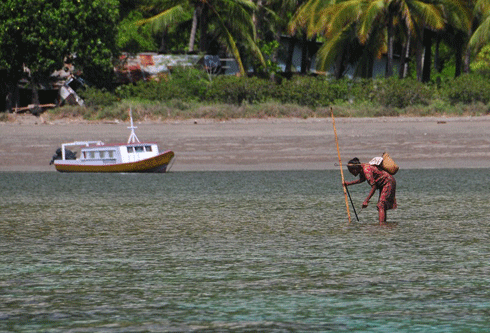
|
Published: 25 February 2013
Devil of a disease
It’s difficult to imagine how anyone involved with saving the Tasmanian devil could find much cause for optimism. Devil numbers are plummeting so drastically that if nothing is done, they could become extinct in the wild within two decades. But conservation efforts recently reached a significant milestone that may yet snatch the devil from the jaws of extinction.
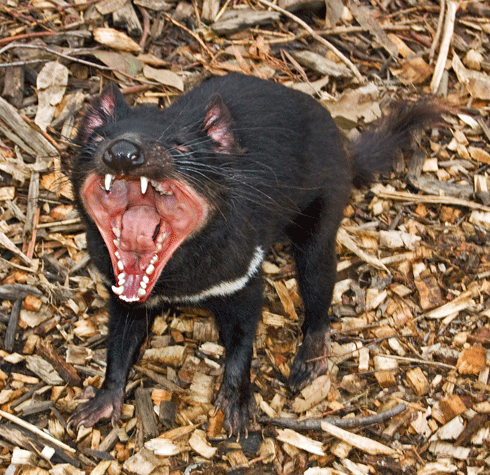
|
|
A healthy devil displaying the gape that made Taz, the Bugs Bunny cartoon character, a household name. Credit: Save the Tasmanian Devil Program
|
The disease behind this wipeout – devil facial tumour disease – has baffled researchers with its ability to evade the devils’ immune systems and kill every animal it infects. While there are small pockets of disease-free devil populations left in Tasmania, the disease continues its unstoppable march of destruction across the island, advancing around 5-7 kilometres each year.
But there is still a sense of hope amongst devil researchers. For perhaps the first time since the disease was discovered in 1996, conservation efforts have achieved a significant victory with the establishment of a large, genetically diverse insurance population of captive devils in zoos and wildlife institutions around Australia.
‘We can be confident that we’re not going to see extinction of the Tasmanian devil because we’ve got this insurance population – it’s well maintained, it’s genetically representative of the wild population,’ said Dr Phil Bell, manager of the Save the Tasmanian Devil Program.
‘It just gives us that degree of confidence and freedom now to think about how we approach other aspects, how we manage the disease and how we manage the animals in the wild.’
The captive insurance population consists of 500 disease-free devils representative of the genetic diversity of devils in the wild. The idea is that these captive animals can preserve the gene pool until such time as it is safe to release them back into the wild. (Interestingly, according to research published last year involving the University of Tasmania’s Dr Menna Jones, the species had a naturally low genetic diversity before the disease appeared, another possible factor contributing to the current crisis.)
Already animals from the captive insurance population have been relocated to a disease-free new home in the wild. In November last year, a small group was transferred to Maria Island off the east coast of Tasmania. The island has the ideal habitat for devils, although until now has lacked a native population of these animals.
‘Maria Island is considered part of our insurance population so those animals are monitored, their breeding is monitored, the genetics are monitored, and those animals could become the source for releases into the wild at some stage in the future,’ said Dr Howel Williams, director of the Save the Tasmanian Devil Program.
‘Virtual’ islands are also being considered – locations around mainland Tasmania that are either disease-free or can be made disease-free by removal of all existing devils, then sealed off using a ‘devil-proof fence’ so no wild devils can enter.
‘There’s a population in the northwest corner which is currently disease-free and we’re working with the land-owner there to put a fence in place that hopefully will stop the spread of disease,’ said Williams.
This fence would stretch 20–30 kilometres around the safe area and would incorporate a major road and large intertidal area, both of which pose a challenge to the fence designers. Other virtual islands include two adjoining peninsulas on the south-eastern corner of Tasmania, and an area of Coles Bay.
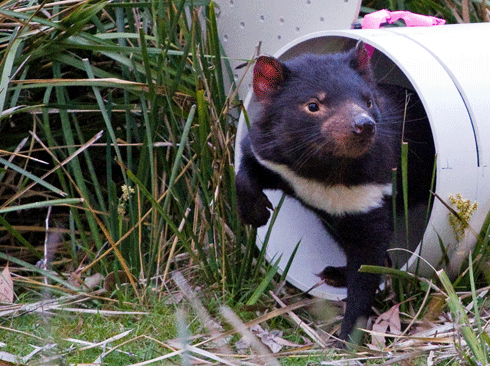
|
|
A healthy young devil takes its first step to freedom on Maria Island, November 2012. Credit: Save the Tasmanian Devil Program
|
But the long-term hope is that the entirety of Tasmania will one day become disease-free, or the devils become resistant to the disease, and the population can be restored across the island.
Helping the devils combat the disease is not proving easy. The disease is unique for a number of reasons: it is 100 per cent fatal; it appears to be totally invisible to the devil immune system so tumours take root and grow without opposition; the tumour cells themselves appear to be immortal; and the disease does not respond to treatment such as chemotherapy.
Professor Greg Woods says the tumours are also unusual in that they are not so much a cancer as a living organ that is being transplanted from one animal to the next.
‘When humans have a transplant, first of all you have to match the recipient to the donor and if it’s not a perfect match, which it rarely is, the recipient is on drugs to suppress their immune system,’ said Prof. Woods, professor of immunology at the University of Tasmania’s Menzies Research Institute Tasmania.
However in the case of devil facial tumour disease, the devils’ immune systems don’t recognise the tumour cells as foreign. Researchers initially thought the devils’ immune systems were deficient, and conducted an experiment in which they transplanted a skin graft from one devil to another to see how the recipient’s immune system handled the graft.
‘The graft was rejected, which tells us that the devils have that capacity to recognise foreign tissue. So there must be something special about the tumour cells,’ Woods said.
Researchers are now examining the tumour cells to find out if they are suppressing or short-circuiting the immune response in some way.
‘We thought maybe that was the case, but we discovered we could activate lymphocytes from a healthy devil, mix them with tumour cells in culture and they’ll kill the tumour cells quite well, so we know that the devil’s immune system has the capacity to kill the tumour cells,’ added Woods.
Armed with the knowledge that devils have the capacity to recognise and react to tumour cells in the laboratory, the next step is to try and induce this reaction in vivo.
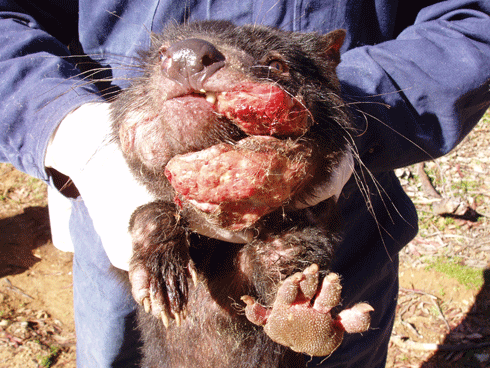
|
|
A Tasmanian devil with advanced facial tumour disease. Credit: Save the Tasmanian Devil Program
|
However, Woods believes it’s a race against time.
‘With the insurance population, it does allow a bit of extra time but it would be nice if we could protect the animals before they needed to be reintroduced from the captive population.’
The Save the Tasmania Devil Program is operating on a long time frame – 30–50 years – so they’re not expecting quick answers. One of the big questions the program is currently grappling with is how to deal with existing wild population of devils.
‘We were looking at populations collapsing and then becoming extinct as the disease spread and what we’re seeing is that populations are being far more persistent,’ Williams said.
That is partly because, with less competition and more nutrition, the animals are maturing and breeding far earlier than they used to, so are able to reproduce before they succumb to the disease.
However this poses a dilemma for conservation efforts. While the wild devils’ persistence is a good thing in the short term, in the long term it may not be.
‘We’re currently trying to think our way through a bit of a quandary, and that is, is it best to get extinction and then come through and replace with a healthy population or do you live with disease in the long term?’ Williams said.
‘We don’t know the answer to that question yet, but it’s quite central to where we go to in the future.’
|
In 2010, Dr Alistair Hobday, a senior research scientist with the CSIRO, published research measuring the response distance at which motorists need to detect to different animals while driving at night in order to avoid running them over. |
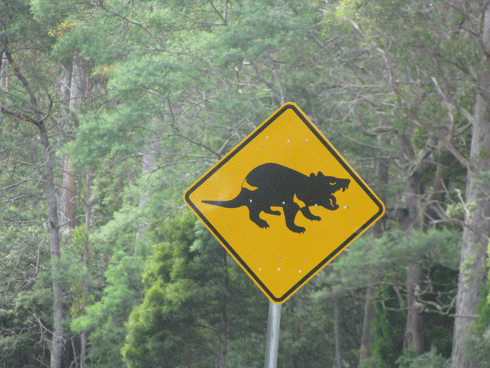
For Tasmanian drivers, these road signs should remind them to slow down to avoid killing devils, particularly if the area’s a designated roadkill hotspot. Credit: © Audrey Bendus & Arthur Chapman via flickr under Creative Commons CC BY-NC-SA 2.0 licence
|
Hobday discovered that Tasmanian devils – being mostly black – are the hardest of all species to see between dusk and dawn. |
Combining these findings with reaction times and braking distances, Hobday determined that drivers can travel no faster than 54 km/h with their lights on high beam, or 38 km/h on low beam, if they want to give themselves enough reaction time to avoid hitting a devil on the road. |
It was the first time in Australia that safe driving speeds had been quantified across the range of our native animals. |
‘About 80 per cent of roadkill occurs on 20 per cent of roads, and around Tasmania there are about 50 to 60 high-density roadkill “hotspots”,’ said Hobday. |
‘In terms of management, that's an advantage. It means we can target our mitigation in those areas. |
‘For animals like devils and quolls, roadkill is probably a significant impact on the population. It's estimated that roadkill contributes about 5 per cent of the mortality rate of devils.’ |
Precise locations of these hotspots can be downloaded as files for a driver’s GPS, or as printable maps. |
Edited from the ‘Save the Tasmanian Devil’ website |


